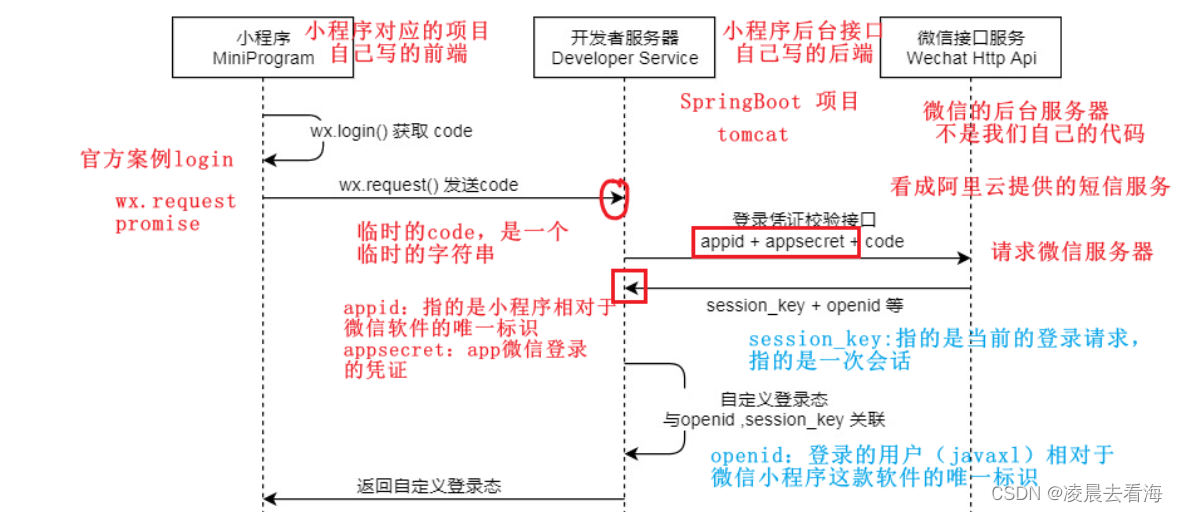目录
一 什么是微信登录功能
微信小程序登录功能一般用于开发微信小程序的时候,我们需要使用微信授权登录我们的微信小程序,本篇博客就微信小程序实现微信授权登录以及springboot服务端代码逻辑做一个详细讲解。
二 实现微信登录功能的整体逻辑
首先,我们来看微信小程序登录的官方流程图:
从上面这个流程图可以看见,微信登录主要分为以下几个步骤:
1.微信小程序通过调用wx.login()方法来获取一个code。
2.微信小程序前端得到这个code后,通过发送请求,把这个code传给我们后端服务器。
3.我们后端服务接收到这个code后,再加上微信小程序校验凭证:appid,secret, grant_type(这三个是通过我们创建的微信小程序生成的), 以及我们得到的js_code一并作为参数,使用HttpCent发送请求给微信接口服务,这样就会给我们返回一个openid,这个openid就是每一个用户登录的唯一标识,我们就是通过这个来判断用户是否登录。
4.根据得到的openid去数据库中查找用户,从而判断用户是否登录,如果没登录,我们在服务端需要做一个添加该用户的sql操作,记住,必须要有这个openid字段。
5.逻辑业务完成之后,我们就可以返回查询到的User对象并且生成一个jwt令牌给微信小程序前端,为什么要给用户生成一个jwt令牌?因为这用户在执行小程序的其他功能时,通过拦截器判断用户是否已经登录,有些功能需要登录才能放行。
至此,微信登录功能就已经全部完成!
三 微信登录功能实现步骤
① 在微信小程序端定义好请求路径,同时需要传入参数code(需要学习微信小程序的前端编码技术)
② 在服务端配置好微信小程序的appid和secret(这个是在你创建的微信小程序后生成的)
另外,如果你是要jwt令牌的话,还需要配置微信登陆的jwt令牌。
③ 在controller层接收到前端传来的code,并且调用server层实现相关登录逻辑后,得到一个查询到的用户对象,并且未这个对象生成jwt令牌,返回给微信小程序前端。
@RestController @Slf4j @RequestMapping("/user/user") @Api("C端用户相关接口") public class UserController { @Autowired private UserServer userServer ; @Autowired private JwtProperties jwtProperties ; @PostMapping("/login") @ApiOperation("微信登录") public Result<UserLoginVO> login(@RequestBody UserLoginDTO userLoginDTO){ log.info("微信用户登录code:{}" , userLoginDTO.getCode()) ; // 微信登录 User user = userServer.wxLogin(userLoginDTO) ; // 为微信用户生成jwt令牌 HashMap<String, Object> claims = new HashMap<>(); claims.put(JwtClaimsConstant.USER_ID, user.getId()) ; String jwt = JwtUtil.createJWT(jwtProperties.getAdminSecretKey(), jwtProperties.getUserTtl(), claims); // 封装返回的UserLoginVo UserLoginVO userLoginVo = UserLoginVO.builder() .id(user.getId()) .openid(user.getOpenid()) .token(jwt) .build(); return Result.success(userLoginVo) ; } }④ 实现server层逻辑,主要用过接收code后,在通过另外几个参数使用HttpClient请求方式,想微信服务地址发送请求,得到用户唯一标识openid。然后通过openid去数据库表查找该用户,最后返回该用户。
@Service @Slf4j public class UserServerImpl implements UserServer { // 定义访问wx接口服务的地址 public static final String wx_login = "https://api.weixin.qq.com/sns/jscode2session" ; //固定的 @Autowired private WeChatProperties weChatProperties ; @Autowired private UserMapper userMapper ; public User wxLogin(UserLoginDTO userLoginDTO) { // 1.调用微信接口服务,获取当前用户的openid HashMap<String, String> map = new HashMap<>(); map.put("appid",weChatProperties.getAppid()); //小程序appid map.put("secret",weChatProperties.getSecret()); //小程序appSecret map.put("js_code", userLoginDTO.getCode()) ; //登录微信时获取的code map.put("grant_type","authorization_code") ; //授权类型:authorization_code(固定的) String json = HttpClientUtil.doGet(wx_login, map); //返回的是一个json对象 // 把json格式的openid解析出来 JSONObject jsonObject = JSON.parseObject(json); String openid = jsonObject.getString("openid"); System.out.println("openid="+openid); // 2.判断openid是否为空,如果为空表示登录失败,抛出异常 if(openid==null){ throw new LoginFailedException(MessageConstant.LOGIN_FAILED) ; //登陆失败 } // 3.判断当前用户的openid有没有在我们的数据库中,如果没有,则说明是新用户,我们需要存起来 User user = userMapper.getByOpenid(openid); if (user==null){ System.out.println("该用户为新用户..."); user = User.builder() .openid(openid) .createTime(LocalDateTime.now()) .build(); // 保存user对象到数据库 userMapper.insertUser(user); } // 4.返回用户对象 return user ; } }至此,整个微信登录功能就实现成功啦!


